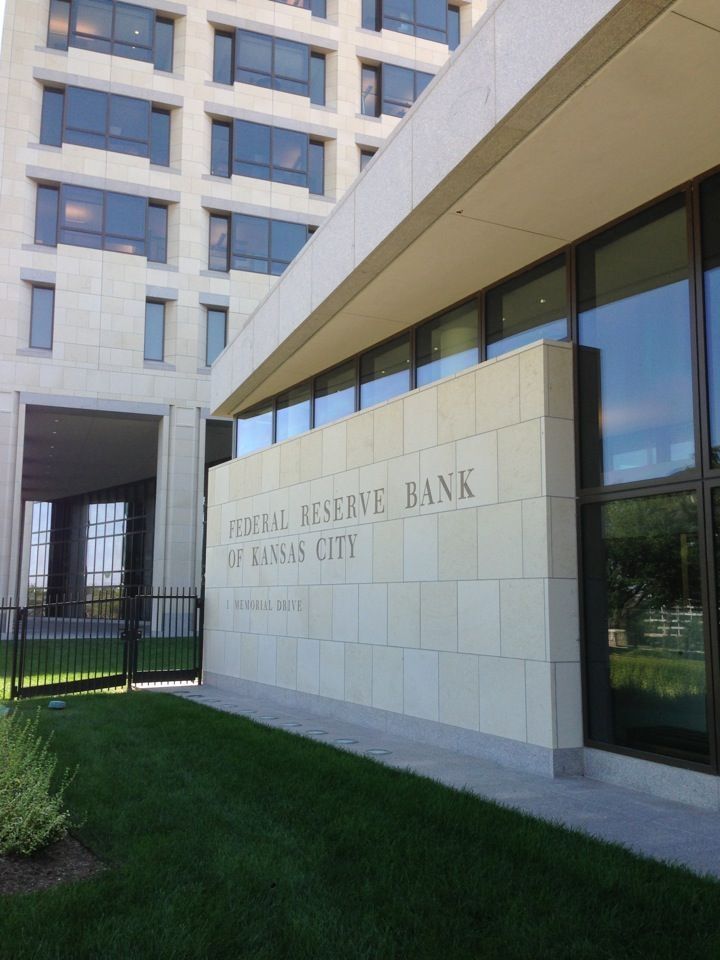Fed Beige Book: Commercial real estate conditions continued to deteriorate in many Districts
Overall Economic Activity
Economic activity continued to increase across all Districts, with the pace of growth characterized as slight to modest in most Districts. Changes in activity varied greatly by sector. Manufacturing activity generally increased at a moderate pace. Residential housing markets continued to experience steady demand for new and existing homes, with activity constrained by low inventories. Banking contacts also cited increased demand for mortgages as the key driver of overall loan demand. Conversely, commercial real estate conditions continued to deteriorate in many Districts, with the exception being warehouse and industrial space where construction and leasing activity remained steady. Consumer spending growth remained positive, but some Districts reported a leveling off of retail sales and a slight uptick in tourism activity. Demand for autos remained steady, but low inventories have constrained sales to varying degrees. Reports on agriculture conditions were mixed, as some Districts are experiencing drought conditions. Districts characterized the outlooks of contacts as generally optimistic or positive, but with a considerable degree of uncertainty. Restaurateurs in many Districts expressed concern that cooler weather would slow sales, as they have relied on outdoor dining. Banking contacts in many Districts expressed concern that delinquency rates may rise in coming months, citing various reasons; however, delinquency rates have remained stable.
Federal Reserve Bank of Kansas City

Summary of Economic Activity
Tenth District economic activity expanded slightly in September despite a pullback in consumer spending for the first time since early summer. Retail, restaurant, auto and tourism sales declined since the previous survey, and expectations for consumer spending were mixed. Retail and auto contacts anticipated moderate gains, while restaurant and tourism contacts anticipated declines heading into the winter months. Manufacturing production and new orders increased modestly at both non-durable and durable goods plants. Transportation and wholesale trade sales also rose modestly, but sales in the professional and high-tech sectors fell. Residential real estate activity continued to increase at a moderate pace, but commercial real estate conditions weakened. Energy activity stabilized somewhat, but revenues, employment and capital expenditures continued to decline in the sector. The agriculture sector improved slightly in September, although drought conditions intensified in parts of the District. Most industries continued to add jobs, but overall employment levels were modestly below year-ago levels. Wages and prices rose modestly, and similar gains were expected in the coming months.
Employment and Wages
District employment increased slightly since the last survey period but remained modestly below year-ago levels. Contacts in the wholesale trade, health services, and real estate sectors reported the largest employment gains, while tourism, transportation and manufacturing contacts reported slight increases. Restaurant contacts noted a slight decrease in employment following a modest gain during the previous survey period. Employment levels remained below year-ago levels in most industries, but contacts in every sector except tourism expected to add jobs in the months ahead.
A slight majority of contacts in the services sector reported labor shortages, including openings for truck drivers, retail workers, and skilled technicians. Wages rose modestly and were expected to continue to do so in the coming months. The majority of restaurant, wholesale, transportation and auto sales respondents expected wage growth over the coming year to be similar to that of last year. However, the majority of tourism and health services contacts expected slower wage growth than a year ago.
Prices
Input and selling prices rose modestly in the services and manufacturing sectors in September and continued modest increases were expected in the next few months. Prices in the retail industry rose moderately and were well above year-ago levels. Transportation contacts noted a slight increase in input and selling prices, although prices remained moderately below year-ago levels. Selling prices increased moderately for construction supplies, but were expected to remain flat in the upcoming months. Restaurant prices edged up during this survey period and remained moderately above year-ago levels. Prices of raw materials and finished products rose modestly in the manufacturing sector and additional increases were anticipated in the coming months.
Consumer Spending
Consumer spending fell modestly since the last survey period which was the first decline since early summer. Restaurant and auto sales experienced the largest declines, both following moderate increases during the previous survey period. Tourism and retail sales fell slightly, after experiencing consistent gains throughout the summer. Tourism, restaurant, and auto sales were moderately below year-ago levels, however retail sales remained modestly above. In the next six months, many restaurant and auto contacts indicated that they will need to increase marketing or sales and the majority of respondents in the retail and restaurant sectors noted that they will need to hire new employees. Retail and auto contacts expected moderate increases in sales over the next few months, while restaurant and tourism respondents expected continued declines.
Manufacturing and Other Business Activity
Manufacturing activity expanded modestly in September, but remained moderately below year-ago levels. Both the non-durable and durable goods sectors experienced modest gains in production and new orders, marking a slight slowdown in the pace of growth for non-durable goods. Contacts anticipated further increases in production and new orders in the coming months. Capital expenditures were consistent with levels from a year ago in the non-durable sector, while down slightly from a year ago in the durable sector. The majority of manufacturing contacts expected to hire new employees in the next six months.
Outside of manufacturing, sales in transportation and wholesale services increased modestly during the survey period, a weakened pace of growth for both sectors relative to this summer. Sales in professional and high-tech services declined since the last survey and were modestly below year-ago levels. Contacts in transportation and professional and high-tech services expected modest increases in sales and slight declines in capital expenditure in the coming months, while wholesale respondents expected moderate increases in both measures.
Real Estate and Construction
Residential real estate activity grew moderately since the last survey, but commercial real estate conditions continued to decline. Home prices rose moderately as inventories fell further. Home sales held steady, and remained moderately above a year ago. In addition, contacts expected moderate growth in both sales and prices in the upcoming months. Construction supply sales continued to rise modestly, keeping them moderately above year-ago levels. Since the previous survey period, commercial real estate conditions continued to worsen with a modest increase in vacancy rates, a slight increase in developer’s difficulty in accessing credit, and slight declines in absorption rates, sales, and rents. Commercial construction, however, increased slightly for the first time following consistent declines since early spring. Overall, expectations improved in the commercial real estate sector compared to the previous survey, but contacts still expected conditions to worsen in the next few months.
Banking
Bankers reported modest growth in overall loan demand, with strong increases in residential real estate loan demand and slight increases in consumer installment loan demand. Other lending categories continued to slow, with slight declines in commercial real estate loan demand and modest declines in commercial, industrial, and agricultural loan demand. Since the last survey, credit standards tightened modestly for commercial real estate lending and tightened slightly for commercial, industrial, and consumer lending. Deposit levels increased moderately over the past few weeks. Bankers reported moderate declines in loan quality compared to a year ago and expected strong declines in quality over the next six months.
Energy
District energy activity stabilized somewhat since the previous survey period, but revenues, employment, and capital expenditures continued to decline. The number of active oil and gas rigs in the District was mostly unchanged from August, and drilling and business activity remained significantly lower than a year ago. Prices for oil and gas remained below the average price District firms reported needing for drilling to be profitable. Expected oil prices for the near term were higher than price expectations from earlier in 2020, but longer-term projections were steady. Over a quarter of firms surveyed expected global oil demand to return to pre-COVID levels by Q2 2021, but the majority of contacts didn’t expect oil demand to rebound fully until 2022 or 2023. Moving forward, most firms expected more defaults and bankruptcies in the energy sector, and over half of firms anticipated a large increase in mergers and acquisitions through 2021.
Agriculture
Economic conditions in the Tenth District agricultural sector improved slightly from the previous period despite intensifying drought conditions in some parts of the District. Alongside government payments that were expected to help offset revenue losses, prices for most of the region’s major agricultural commodities increased slightly in late September. However, apart from soybean and hog prices, agricultural prices generally remained low. Drought conditions intensified, particularly in western District states. Through September, the share of corn and soybean acres in poor condition was higher than a year ago and above the national average in all states except Missouri. Extreme drought in portions of Colorado, Wyoming, New Mexico, Oklahoma and Nebraska could further lower crop revenues and reduce income prospects for cow-calf producers impacted by the severe conditions.
For more information about District economic conditions visit: www.KansasCityFed.org/Research/RegionalEconomy



